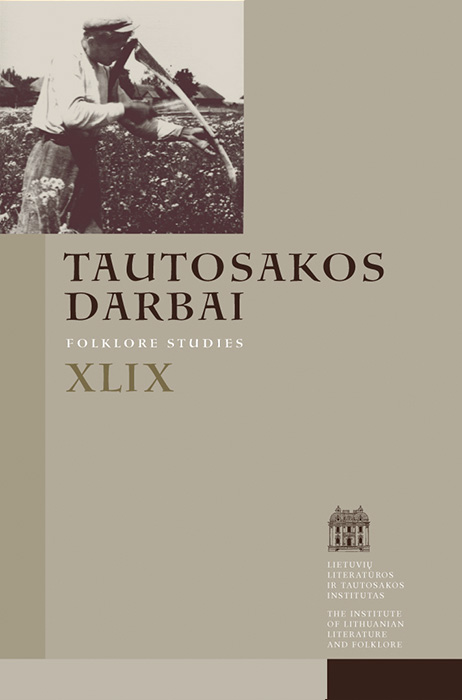The Music Making at the Church Feasts, or Baroque of the 20th–21st Centuries
Abstract
The subject of this article is the music making during the Catholic Church feasts and its development since the Christianization of the Grand Duchy of Lithuania until nowadays, with special emphasis on the music making tradition of the 20th–21st centuries. Following the spread of Christianity, the tradition of the religious feasts was quick to catch on, along with its peculiar Western European customs and culture of the musical styling. According to the historical sources, as early as in the end of the 14th century (that is, barely ten years after the official Christianization) the wind and percussion instruments were played in the Vilnius Cathedral. The academic wind and percussion instruments, having been since ancient times used in the army of various European countries, including the Grand Duchy of Lithuania, became adapted by the musical culture of the manors and dioceses, finding their use during pilgrimages, celebratory processions, services, etc. During the Renaissance and Baroque periods, an especially important social and cultural role was played by the Vilnius Academy, established by the Jesuits, at which also instruction in music was offered. The Jesuits organized particularly pompous processions of the Corpus Christi, which included theatrical performances, participation of numerous musicians and singers, firing guns, etc. According to the archived data, during the Baroque times the majority of the churches or the affiliated brethrens used to possess both the brass and the percussion instruments: usually – two or more trumpets, French horns, and kettledrums. These instruments were regarded necessary in order to celebrate the titular feasts of the parish in the appropriate way, that is, with musical accompaniment, or to travel likewise to the festivities held in the neighborhood. Thus the folk piety tradition of the brass bands got shaped, which, having already disappeared in other Lithuanian regions, continues to live on in Samogitia in the 20th–21st century. It is particularly important in relation to the rituals of visiting the Samogitian Calvary (Žemaičių Kalvarija) – a variety of the popular baroque European tradition of the Way of the Cross (Via Crucis), the first one of which in the Grand Duchy of Lithuania was established in Samogitia. Quite likely, these Stations of the Cross since their very establishment used to be visited ceremoniously, including singing and the appropriate accompaniment by wind instruments and kettledrums. This tradition survived in spite of being prohibited both during the tsarist Russian oppression and during the Soviet atheism periods. During the Soviet occupation the musicians, although being harassed or even arrested, still used to go to play at the religious feasts, thus expressing not only their devotion, but also their protest against the regime of the religious oppression. After Lithuania regained its independence in the end of the 20th century, the new kind of worshipers who had been brought up unaware of the traditional Calvary Hymns singing started the new way of singing accompanied by kanklės (Lithuanian cithertype instrument) and guitars. Still, in spite of this wave of musical pluralism, the brass bands preserved their positions. Until the present day, worshipers visiting the Stations of the Cross at the Samogitian Calvary are accompanied by the musicians playing the brass instruments, who are traditionally rewarded with money. Depending on the particular worshipers’ needs, three kinds of functions performed by the musicians can be discerned: firstly, the group of 4 to 6 musicians may only play; secondly, 2 to 5 musicians lead the prayers both singing and playing; and thirdly (a medium variant), the group of 4 to 6 musicians both plays and sings. The analysis presented in the article allows maintaining that prior to becoming part of the wedding, christening and funeral rituals of the village people, brass instruments had already become an integral part of the musical expression of the exceptional solemnity of folk piety.
Downloads
Most read articles by the same author(s)
- Rūta Žarskienė, Inga Vidugirytė, Asta Skujytė-Razmienė, Gražina Kadžytė, Lina Leparskienė, Vita Džekčioriūtė-Medeišienė, Dalia Zaikauskienė, Chronicle , Tautosakos darbai: Vol. 58 (2019)
- Vida Norvaišienė, Dainius Razauskas, Rūta Žarskienė, Vita Ivanauskaitė-Šeibutienė, Lina Būgienė, Chronicle , Tautosakos darbai: Vol. 49 (2015)
- Radvilė Racėnaitė, Rūta Žarskienė, Živilė Ramoškaitė, Asta Skujytė-Razmienė, Aušra Žičkienė, Chronicle , Tautosakos darbai: Vol. 51 (2016)
- Guntis Pakalnas, Rimantas Sliužinskas, Asta Skujytė-Razmienė, Radvilė Racėnaitė, Vita Ivanauskaitė-Šeibutienė, Rūta Žarskienė, Lina Leparskienė, Andželika Jakubynienė, Chronicle , Tautosakos darbai: Vol. 47 (2014)
- Radvilė Racėnaitė, Asta Skujytė-Razmienė, Ainė Skudutytė, Povilas Krikščiūnas, Gaila Kirdienė, Austė Nakienė, Rūta Žarskienė, Chronicle , Tautosakos darbai: Vol. 50 (2015)
- Austė Nakienė, Daiva Račiūnaitė-Vyčinienė, Rokas Sinkevičius, Aušra Žičkienė, Nijolė Laurinkienė, Rūta Žarskienė, Chronicle , Tautosakos darbai: Vol. 53 (2017)
- Rūta Žarskienė, The Sound of Trumpet will Stir the World and Raise the Dead: Prayers Accompanied by Brass Instruments in the Folk Piety Tradition , Tautosakos darbai: Vol. 55 (2018)
- Rūta Žarskienė, Tracing the Fieldwork of the Folk Music Group Linago (Vytautas Magnus University) , Tautosakos darbai: Vol. 54 (2017)
- Rūta Žarskienė, Brass Bands of the Lithuanian Emigrants in the USA and the National Movement , Tautosakos darbai: Vol. 60 (2020)
- Rūta Žarskienė, Foreword , Tautosakos darbai: Vol. 60 (2020)
